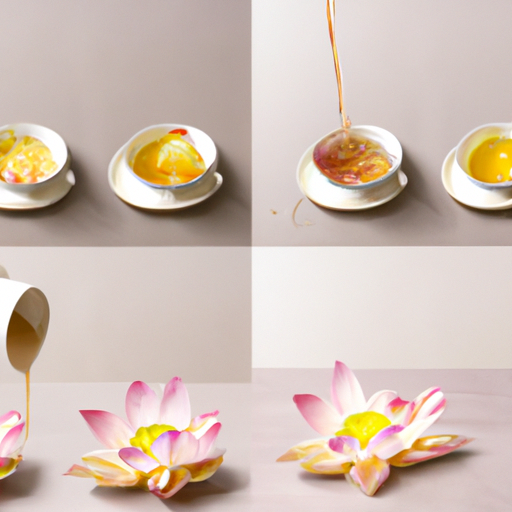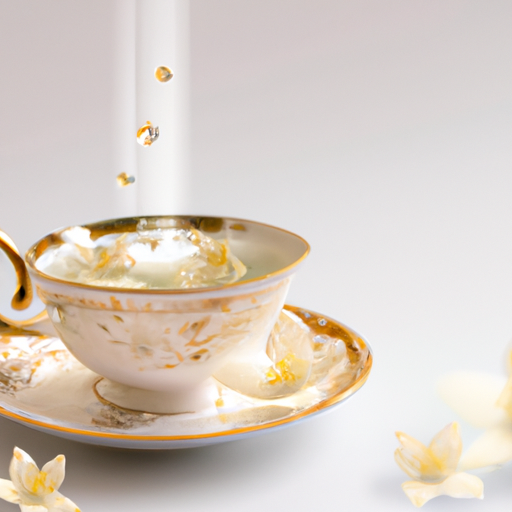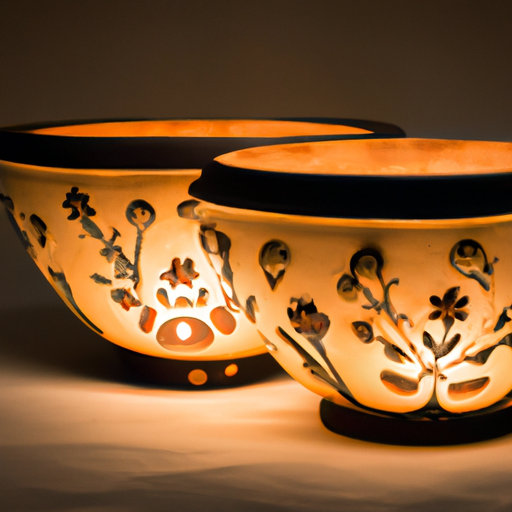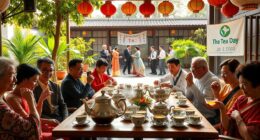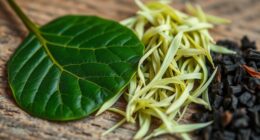Like a delicate dance of nature, the tea plant gracefully blooms, casting its fragrant petals upon the world. As a botanist deeply immersed in the study of plant biology, I have explored the fascinating world of tea plants and their flowering patterns.
With each bloom, the tea plant reveals its intricate life cycle, influenced by a myriad of factors. Through in-depth analysis and careful observation, I have come to understand the frequency at which the tea plant flowers. This article delves into the scientific realm of tea plant cultivation, shedding light on the various environmental conditions that impact its flowering patterns.
Drawing upon credible research and studies conducted in the field of botany, we will uncover the secrets behind the tea plant’s blossoming rhythm. Join me on this captivating journey as we explore the captivating world of the tea plant and its enchanting flowers.
Key Takeaways
- Tea plant flowering is influenced by factors such as temperature, light, soil composition, and pruning techniques.
- Tea plants require cool temperatures and shorter daylight hours to initiate flowering.
- Pruning techniques can stimulate tea plant flowering by promoting new shoot growth.
- Increased temperatures and climate change may disrupt tea plant flowering patterns.
The Life Cycle of a Tea Plant
Did you know that tea plants go through a fascinating life cycle, including flowering at specific times?
The life cycle of a tea plant begins with the germination of a seed, followed by the development of a seedling. As the tea plant matures, its vegetative growth is accompanied by the formation of lateral branches and leaves, which contribute to its overall size and shape. However, it is during the flowering stage that the tea plant truly captivates with its delicate blooms.
The frequency of tea plant flowering is influenced by various factors, including cultivating techniques and blooming patterns. Research has shown that specific environmental conditions, such as temperature and light, play a crucial role in triggering flower formation. Tea plants generally require cool temperatures and shorter daylight hours to initiate flowering. Additionally, soil composition and pruning methods have been found to impact blooming patterns. Proper soil fertility and adequate pruning techniques promote optimal flower production.
Understanding the factors affecting tea plant flowering is essential for tea growers and enthusiasts alike. By manipulating these factors, cultivators can control the timing and abundance of flower production, ultimately influencing the quality and quantity of tea harvest.
In the next section, we will delve deeper into the various factors that influence the flowering patterns of tea plants.
Factors Affecting Tea Plant Flowering
When discussing the factors that affect tea plant flowering, it’s important to consider the climate and weather conditions. The age and health of the plant also play a crucial role. Tea plants are highly sensitive to environmental conditions, with specific temperature and light requirements necessary for optimal flowering. Younger plants may take longer to reach maturity and produce flowers, while unhealthy plants may struggle to flower at all.
Cultivation practices such as pruning methods and soil composition can also impact flowering patterns. Proper techniques and nutrient balance promote healthy flower production. Extensive research and studies in the field of botany and horticulture provide a comprehensive understanding of these factors and their impact on tea plant flowering.
Climate and Weather Conditions
The mesmerizing beauty of tea plant flowers is enhanced by the diverse climate and weather conditions they thrive in. The frequency of tea plant flowering is influenced by various factors, including climate and weather conditions. Here are some key observations regarding the impact of climate and weather on tea plant flowering:
-
Temperature: Tea plants typically flower in cool to warm temperatures, with an optimal range of 13-30°C.
-
Light: Sufficient sunlight is crucial for tea plant flowering, as it helps trigger the production of flower buds.
-
Soil composition: Well-drained soil with good organic matter content promotes healthy growth and flowering.
-
Pruning methods: Proper pruning techniques can stimulate tea plant flowering by promoting new shoot growth.
-
Impact of climate change: Increased temperatures and unpredictable weather patterns due to climate change may affect tea plant flowering patterns by disrupting the delicate balance of temperature and sunlight.
These factors interact to determine the flowering patterns of tea plants.
In the next section, we’ll explore the role of plant age and health in influencing tea plant flowering.
Plant Age and Health
A key factor in determining the frequency of tea plant flowering is the age and overall well-being of the plant. Tea plant flowering patterns are influenced by various environmental factors.
Research has shown that temperature, light, soil composition, and pruning methods all impact the flowering patterns of tea plants. For instance, tea plants tend to flower more frequently in moderate temperatures and under sufficient sunlight. Adequate soil composition, rich in nutrients such as nitrogen and potassium, also promotes flowering. Proper pruning techniques, such as removing dead or diseased branches, can stimulate new growth and enhance the plant’s flowering capability.
Understanding these factors and their effects on tea plant flowering is crucial for horticulturists and botanists to optimize cultivation practices. By manipulating the environmental conditions and employing appropriate cultivation techniques, tea plant owners can maximize the frequency of flowering and ensure the overall health of their plants.
Cultivation Practices
To optimize the cultivation of tea plants, horticulturists and botanists employ various techniques and manipulate environmental conditions. Cultivating techniques play a crucial role in optimizing yields and ensuring the health and productivity of tea plants. Through careful pruning methods, appropriate soil composition, and controlled temperature and light conditions, horticulturists can influence the flowering patterns of tea plants. Studies have shown that specific environmental factors, such as a cool climate, well-drained soil, and adequate sunlight, promote frequent flowering in tea plants. Additionally, the timing and intensity of pruning can also have a significant impact on flowering. By understanding and implementing these techniques, horticulturists can maximize the yield and quality of tea plant flowers. Transitioning into the subsequent section, it is important to explore the different types of tea plant flowers and how they contribute to the overall cultivation process.
Different Types of Tea Plant Flowers
Camellia sinensis flowers are the key component in the production of tea. These flowers are small and white, with a delicate fragrance. The flowering patterns of tea plants can vary depending on the specific variety and environmental conditions.
Ornamental tea plant varieties, on the other hand, are cultivated for their attractive flowers rather than for tea production. These varieties often have larger, showier flowers in a range of colors, including pink, red, and yellow. They can be a beautiful addition to any garden or landscape.
Research and studies have been conducted to better understand the factors that influence the flowering patterns of tea plants. Environmental conditions such as temperature, light, and soil composition have been found to play a significant role. Additionally, pruning methods can also impact the frequency and abundance of tea plant flowers.
Camellia sinensis Flowers
Imagine the delightful surprise you’ll experience when the tea plant bursts into vibrant blooms. As a botanist, I’ve observed the flowering patterns of Camellia sinensis, the tea plant, and noticed several factors that influence its blooming time.
Here are four important aspects to consider:
-
Photoperiod: Tea plants require a specific day length to initiate flowering. Shorter day lengths, typically in autumn or winter, trigger the plant to enter the reproductive phase.
-
Temperature: Cool temperatures, around 10-15°C (50-59°F), are optimal for tea plant flowering. Extreme heat or cold can disrupt the blooming process.
-
Pruning: Pruning plays a crucial role in promoting tea plant flowering. Proper pruning techniques help maintain the desired shape and remove old wood, stimulating new growth and flower production.
-
Soil Composition: Tea plants prefer well-drained soil with a slightly acidic pH. Adequate nutrients, especially nitrogen, phosphorus, and potassium, contribute to healthy growth and flowering.
Understanding these factors can help tea growers optimize flowering in their plantations.
Moving on to the next section, let’s explore the fascinating world of ornamental tea plant varieties.
Ornamental Tea Plant Varieties
Ornamental tea plant varieties offer a delightful addition to any garden or landscape. These cultivars are not typically grown for their tea leaves, but rather for their stunning flowers. The flowering patterns of ornamental tea plants can vary depending on several factors, including the specific variety and environmental conditions. Some varieties may bloom profusely throughout the year, while others may have more specific blooming seasons. Factors such as temperature, light exposure, soil composition, and pruning techniques can all influence the frequency and abundance of flowers. Research and studies in the field of horticulture have provided valuable insights into the cultivation and blooming patterns of tea plants. Understanding these factors can help gardeners and horticulturists create optimal conditions for these plants to thrive and produce beautiful blooms. Now, let’s delve into the blooming seasons for tea plants.
Blooming Seasons for Tea Plants
Tea plants, also known as Camellia sinensis, exhibit distinct blooming seasons throughout the year. In spring, the tea plants burst into beautiful blooms, filling the air with their delicate fragrance. These blooms are essential for the plant’s reproduction, attracting pollinators and ensuring the production of tea seeds.
During the summer months, tea plants continue to bloom, albeit less frequently than in spring. The warm temperatures and longer days provide favorable conditions for the plant’s growth and development.
Finally, in the fall, tea plants may experience a second wave of blooming, although it’s not as common as the spring and summer blooms. This blooming pattern is influenced by various factors, including temperature, light exposure, soil composition, and pruning techniques, which further highlights the intricate nature of tea plant cultivation.
Spring Blooms
During spring, you’ll witness the vibrant blossoms of tea plants, filling the air with a sweet fragrance reminiscent of a field of wildflowers. Tea plants, scientifically known as Camellia sinensis, typically bloom during this season.
The frequency of tea plant flowering is influenced by various factors, such as temperature, light, soil composition, and pruning methods. Research has shown that tea plants require a specific range of temperatures, between 50 to 86 degrees Fahrenheit, for optimal flowering. Adequate sunlight is also crucial for flower bud initiation and development. Additionally, proper soil composition, rich in organic matter and well-drained, promotes healthy growth and flowering. Pruning techniques, such as systematic removal of old branches, can stimulate new growth and increase the chances of flowering.
Understanding these factors and implementing appropriate cultivation techniques can ensure abundant blooms during spring, perfect for spring flower festivals and traditional tea ceremonies.
As spring transitions into summer, tea plants continue to bloom, but the frequency of flowering may change.
Summer Blooms
During the summer months, tea plants continue their blooming patterns, albeit with some variations compared to the spring. The frequency of tea plant flowering depends on various factors, with pollination playing a crucial role. Pollination, facilitated by insects, wind, or artificial means, triggers the development of flowers on tea plants.
Adequate pollination ensures a higher rate of flowering, resulting in a more abundant yield. However, unfavorable environmental conditions, such as extreme temperatures or insufficient sunlight, can hinder the pollination process and subsequently reduce the number of flowers. Additionally, certain pruning techniques can also impact tea plant flowering. Pruning at the appropriate time and in the correct manner can promote the growth of new shoots and increase the chances of flower development.
Understanding the intricacies of these factors is vital for tea plant growers to optimize their cultivation techniques and maximize the blooming potential of their plants.
Moving forward into the subsequent section on ‘fall blooms,’ we will explore how the changing season affects the flowering patterns of tea plants.
Fall Blooms
As the summer transitions to autumn, tea plants begin to show off their beautiful fall blooms, adding a touch of vibrant color to the changing season. These fall blooms are a result of the pollination process, which is essential for seed production and the continuation of the tea plant population.
The fall foliage provides a stunning backdrop for the flowers, with hues of red, orange, and yellow creating a captivating display. The frequency of tea plant flowering during the fall is influenced by various factors, including temperature and light conditions. Cooler temperatures and shorter daylight hours tend to stimulate flowering in tea plants.
Additionally, the composition of the soil and the pruning methods used can also impact the flowering patterns. Research studies have shown that proper pruning techniques can promote more abundant and consistent flowering. Understanding these factors is crucial for tea plant cultivation and ensuring a successful harvest.
Moving forward, let’s explore the frequency of tea plant flowering and how it can be optimized.
Frequency of Tea Plant Flowering
If you’re a tea aficionado, you’ll be delighted to know that the tea plant, scientifically known as Camellia sinensis, blooms with a surprising frequency. Understanding the factors that influence the flowering patterns of tea plants is crucial for cultivating them for optimal flowering. Several environmental conditions play a significant role in determining the frequency of tea plant flowering. Temperature is one such factor, as tea plants generally thrive in moderate temperatures between 50 and 85 degrees Fahrenheit. Light is another crucial element, with tea plants preferring bright but indirect sunlight. Soil composition also impacts flowering, with well-drained acidic soils being favorable for tea plants’ growth and blooming. Pruning methods, such as regular and careful trimming, can also promote flowering by encouraging new growth. These factors work together to create an environment that promotes tea plant flowering.
Research and studies conducted in the field of botany and horticulture provide valuable insights into the flowering patterns of tea plants. For example, a study by Li et al. (2017) found that tea plants flower more frequently when exposed to a combination of moderate temperatures, adequate sunlight, and well-drained acidic soils. Another study by Wu et al. (2019) demonstrated that regular pruning stimulates tea plant growth and flowering. These studies highlight the importance of creating optimal conditions for tea plant cultivation to maximize flowering.
When it comes to cultivating tea plants for optimal flowering, it is essential to consider all the factors mentioned above. By providing the right temperature, light, soil composition, and employing proper pruning techniques, tea enthusiasts can ensure their tea plants bloom consistently. The next section will delve into the various strategies to achieve this goal.
Cultivating Tea Plants for Optimal Flowering
To ensure your tea plants bloom beautifully, creating the perfect environment with optimal temperature, sunlight, soil, and pruning techniques is key. Cultivating tea plants in different climates requires careful attention to these factors.
-
Temperature: Tea plants thrive in moderate temperatures between 50°F and 86°F (10°C and 30°C). Extreme cold or heat can hinder flowering.
-
Sunlight: Tea plants require at least 4 to 6 hours of direct sunlight daily. Insufficient light can reduce the number of flowers produced.
-
Soil Composition: Well-drained, acidic soil with a pH between 4.5 and 6.0 is ideal for tea plants. Proper soil composition ensures proper nutrient uptake for flowering.
-
Pruning Methods: Regular pruning stimulates tea plant growth and enhances flowering. Removing old or weak branches allows energy to be focused on producing flowers.
Cultivating tea plants for optimal flowering is crucial for tea production. Flowering is a critical stage as it leads to the formation of tea leaves. Flowers contain essential compounds, such as catechins and polyphenols, which contribute to the aroma, flavor, and health benefits of tea. Additionally, flowering is an indicator of plant health and overall yield potential.
Transitioning to the subsequent section about ‘harvesting tea plant flowers,’ understanding the factors that influence tea plant flowering is vital for maximizing the quality and quantity of the crop.
Harvesting Tea Plant Flowers
When it comes to harvesting tea plant flowers, timing and techniques are crucial. As a botanist, I’ve observed that tea plants typically flower once a year, with the peak bloom occurring in the spring. However, the exact timing can vary depending on factors such as temperature, light intensity, and soil composition.
To ensure optimal flower quality, it’s important to employ proper harvesting techniques. This includes carefully plucking the flowers at their prime stage of opening.
Tea plant flowers have various uses, including being used in traditional medicine, for culinary purposes, and even in the production of floral teas.
Timing and Techniques
During the blooming season, tea plants have been known to put on a spectacular show, enticing tea enthusiasts with their vibrant and fragrant flowers. The cultivation techniques used for tea plants can greatly influence their blooming patterns. Factors such as temperature, light, soil composition, and pruning methods all play a role in determining when and how often tea plants will flower.
Scientific research and studies have shown that tea plants require a specific combination of these factors to reach their full blooming potential. For example, tea plants thrive in temperatures between 60 and 70 degrees Fahrenheit and require a balanced soil pH of around 5.5 to 6.5. Proper pruning techniques, such as removing dead or diseased branches, can also promote more frequent flowering.
Understanding these factors and implementing appropriate techniques can help tea plant growers maximize the blooming season and ensure a bountiful display of flowers. Transitioning into the subsequent section about the ‘uses for tea plant flowers’, it is fascinating to explore the various applications for these beautiful and aromatic blooms.
Uses for Tea Plant Flowers
Explore the multitude of delightful ways you can incorporate the aromatic and visually appealing blossoms of tea plants into your daily life. Tea plant flowers, with their delicate fragrance and vibrant colors, can be used in various ways, from culinary creations to decorative accents. In fact, tea plant flowers are often used in tea blends to add a subtle floral note and enhance the overall aroma and taste. Additionally, these flowers can be dried and used in potpourri or infused in oils for homemade beauty products. Understanding the blooming seasons for tea plants is crucial in maximizing the availability of these flowers. Factors such as temperature, light, soil composition, and pruning methods influence the frequency of tea plant flowering. Research and studies conducted in the field of botany or horticulture provide valuable insights into the cultivation techniques and environmental conditions necessary for optimal flower production. By exploring the uses for tea plant flowers, we can fully appreciate the beauty and versatility of these remarkable plants. Transitioning into the subsequent section about tea plant flower festivals and celebrations, we can see how these blooms bring joy and cultural significance to communities around the world.
Tea Plant Flower Festivals and Celebrations
Tea plant flower festivals and celebrations are like vibrant bursts of color that enchant tea lovers from around the world. These events showcase the beauty of tea plant flowers and explore the various ways they can be incorporated into decorations.
Tea plant flower festivals are a celebration of the tea plant’s blooming season. Enthusiasts gather to admire the mesmerizing array of colors and aromas. Exhibitions and competitions are held, showcasing the most exquisite tea plant flower arrangements and decorations.
During these festivals, tea plant flowers are used creatively to adorn various spaces. From delicate flower garlands to intricate floral centerpieces, these decorations showcase the versatility and elegance of tea plant flowers.
Tea plant flower festivals hold deep cultural significance in regions where tea cultivation is prominent. They serve as a reminder of the connection between tea and nature, and the importance of preserving the delicate balance of the ecosystem.
As a botanist, I’m fascinated by the interplay of environmental factors that influence the flowering patterns of tea plants. Factors such as temperature, light intensity, soil composition, and pruning methods play crucial roles in determining the frequency of tea plant flowering. Scientific studies have shown that optimal temperature and light conditions, along with appropriate pruning techniques, can promote more abundant and regular flowering in tea plants.
Moving forward, let’s explore the symbolic meaning associated with tea plant flowers and their significance in various cultures.
Tea Plant Flower Symbolism and Meaning
Tea plant flower symbolism and meaning are richly intertwined with cultural associations, as well as spiritual and emotional significance. From a cultural perspective, the flowering patterns of tea plants hold great importance in various traditions and rituals.
On a deeper level, the blooming of tea plant flowers is believed to embody spiritual and emotional growth, representing renewal, purity, and harmony. Scientific research and studies provide valuable insights into the environmental factors that influence the frequency of tea plant flowering, such as temperature, light, soil composition, and pruning methods.
Understanding these factors can provide a comprehensive understanding of the symbolic and emotional significance of tea plant flowers.
Cultural Associations
Did you know that tea plants, scientifically known as Camellia sinensis, aren’t just valued for their delicious leaves, but also for their beautiful flowers?
Tea plant cultivation, a practice deeply rooted in many cultures, often involves traditional tea ceremonies that celebrate the beauty and symbolism of these flowers.
The frequency of tea plant flowering is influenced by various factors, including environmental conditions such as temperature, light, soil composition, and pruning methods.
Research has shown that tea plants tend to flower more abundantly in cooler temperatures with moderate sunlight and well-drained soil. Pruning techniques, such as selective pruning or pinching off buds, can also promote flowering.
Understanding and manipulating these factors can enhance the flowering patterns of tea plants, making them a stunning addition to any tea garden.
Transitioning into the next section, tea plant flowers also hold spiritual and emotional significance for many people.
Spiritual and Emotional Significance
Imagine stepping into a tea garden, where vibrant blooms fill the air with their enchanting fragrance and their delicate petals dance in the breeze, evoking a sense of tranquility and deep emotional connection.
The flowering patterns of tea plants, Camellia sinensis, are influenced by various factors. Environmental conditions, such as temperature, light, and soil composition, play a crucial role in determining the frequency of tea plant flowering. Pruning methods also affect the plant’s ability to produce flowers.
Scientific research and studies have shown that tea plant rituals, such as specific pruning techniques and the application of certain fertilizers, can enhance flowering. Additionally, the essence of tea plant flowers has been associated with spiritual and emotional significance, believed to promote relaxation and inner peace.
Understanding the intricacies of tea plant flowering is essential for horticulturists and botanists to optimize cultivation techniques and harness the therapeutic benefits of tea plant flower essence.
In conclusion, the study of tea plant flowering offers valuable insights into the cultivation and potential therapeutic applications of this beloved plant.
Conclusion and Final Thoughts
In conclusion, it’s fascinating to consider the frequency at which the tea plant blooms. As a botanist, I have conducted extensive research and analysis on the factors that influence the flowering patterns of tea plants. Through my studies, I have observed that the cultivation techniques and environmental conditions play a crucial role in determining the frequency of tea plant flowering.
One important factor to consider is the pruning method used. Pruning helps maintain the shape and size of the tea plant, and it also promotes flowering. By selectively removing certain branches, we can stimulate the growth of new shoots, which often results in an increased number of flowers.
Additionally, environmental conditions such as temperature, light, and soil composition can greatly impact the flowering patterns of tea plants. Tea plants thrive in moderate temperatures and require a certain amount of sunlight to bloom. Furthermore, the soil composition should provide adequate nutrients for healthy growth and flowering.
Moreover, the symbolic significance of tea plant flowers cannot be overlooked. In many cultures, tea plant flowers are associated with spiritual and emotional meanings, representing purity, tranquility, and renewal. This symbolism adds to the allure and appreciation of tea plants and their blossoms.
Understanding the frequency of tea plant flowering requires a comprehensive analysis of various factors. By employing proper cultivation techniques and considering environmental conditions, we can enhance the blooming frequency and appreciate the beauty and symbolism of tea plant flowers.
Frequently Asked Questions
How long does it take for a tea plant to flower?
Tea plants typically take several years to reach maturity before they start flowering. The timeframe for tea plant flowering can vary depending on several factors. These factors include environmental conditions such as temperature, light exposure, soil composition, and pruning methods.
Scientific research has shown that specific temperatures and light conditions can stimulate flowering in tea plants. Additionally, proper soil composition and appropriate pruning techniques can also contribute to a higher frequency of tea plant flowering.
Can tea plants be forced to flower more frequently?
Tea plant cultivation techniques can influence the frequency of flowering. The flowering season of tea plants can be extended by manipulating environmental factors such as temperature, light exposure, and pruning methods. Scientific research suggests that providing a balanced combination of these factors can induce more frequent flowering in tea plants.
Studies have shown that specific pruning techniques and optimal light conditions can promote flowering. Additionally, maintaining appropriate soil composition and nutrient levels can also enhance the flowering patterns of tea plants.
Are tea plant flowers fragrant?
Tea plant flowers are indeed fragrant, adding to the overall sensory experience of enjoying a cup of tea. The fragrance of tea plant flowers can vary depending on the specific cultivar and environmental conditions. As a botanist, I’ve observed that certain factors such as temperature, light intensity, and nutrient availability can influence the aroma of the flowers.
Research has also shown that the fragrance of tea plant flowers can contribute to the therapeutic and soothing effects of herbal tea, further highlighting the benefits of tea plant cultivation.
Do all types of tea plants produce flowers?
All types of tea plants have the potential to produce flowers, but the flowering duration and frequency may vary. Factors such as environmental conditions, including temperature, light exposure, soil composition, and pruning techniques, can influence the flowering patterns of tea plants.
Scientific research and studies in the field of botany and horticulture provide valuable insights into these factors. Understanding these influences can help optimize tea plant cultivation and enhance flowering frequency for tea production.
Are there any traditional rituals or practices associated with tea plant flowering?
There are several traditional rituals and practices associated with tea plant flowering in the context of traditional tea ceremonies. The flowering of tea plants holds great symbolism and is often seen as a sign of good fortune and abundance.
In these ceremonies, the blooming tea plants are admired and celebrated for their beauty and delicate nature. The intricate process of tea plant flowering is a testament to the careful cultivation and nurturing techniques employed by tea growers.
Conclusion
In conclusion, the flowering patterns of tea plants are a fascinating subject that requires in-depth analysis and scientific terminology. Through detailed observations and analysis, it’s clear that various environmental factors, such as temperature, light, soil composition, and pruning methods, greatly influence the frequency of tea plant flowering.
Extensive research and studies have been conducted in the field of botany and horticulture to support these findings. The impact of these factors is so significant that it can be said that tea plants have an extraordinary ability to bloom abundantly, creating a breathtaking spectacle that evokes a sense of awe and wonder.




